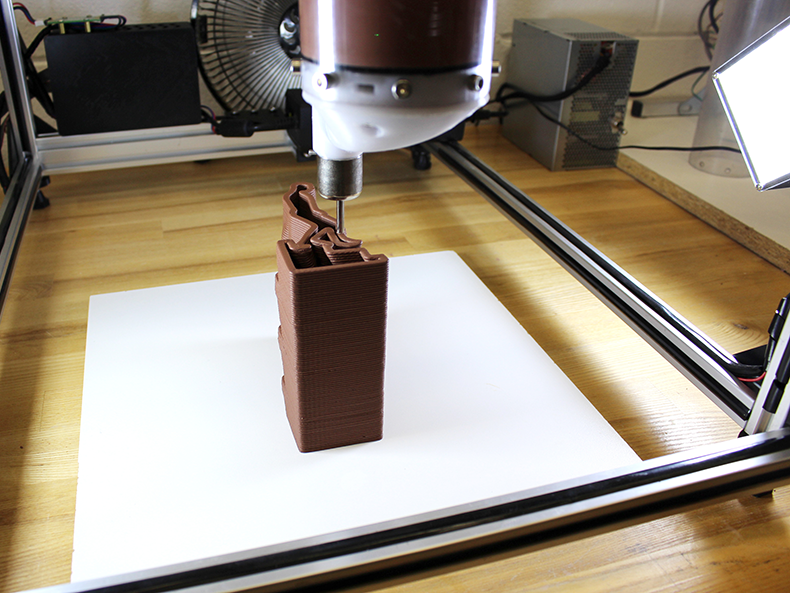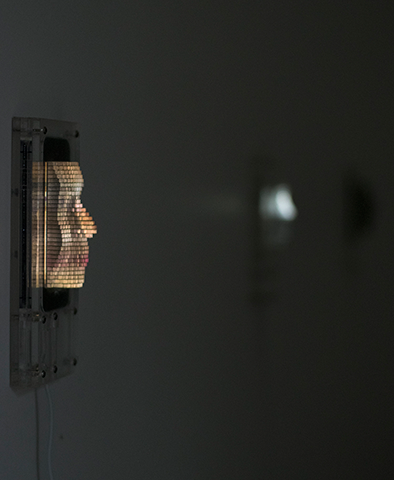Assistant Professor, Object Design & Fabrication
School of Craft & Emerging Media, AUArts
AUArts: What do you do?
Bryan Cera: My title at AUArts is Assistant Professor in Object Making and Emerging Technology. It really sums up well what I do. I'm somewhere between an artist and an engineer and a technologist. I’m mostly interested in a couple of things. One, how emerging technologies influence how we think and move in society in general. And more specifically, I'm interested in how it changes the way that we make things or think about making things – think about changing the world around us.
I teach in and started a minor program, Object Design and Fabrication. It’s a program that's meant to complement any major area of study at AUArts, whether it's in fine arts or craft or design. It’s about exploring cutting-edge tools and emerging technologies – a lot of them are digital-based technologies. Exploring those and how they might be folded into more traditional practices, and also how they might bridge gaps between vocations that seem separate.
I'm most excited when I have a classroom with a bunch of students who think really differently, who have established vocabularies and ways of thinking from their program areas,
And I love putting a challenge forward in the form of an assignment and then seeing how someone from Jewellery and Metals approaches solving that problem versus someone in Painting. I think that all these practicums kind of boil down to process; the differences are all at the surface. But it's really interesting to see how students utilize the vocabulary and the kind of ways of looking and thinking that they've developed in their own area.

AUArts: What’s an example of a first-year course that someone might take with you?
Bryan: The one big focus of the first-year Object Design course is using readily available, relatively cheap materials to prototype objects. So we focus mainly on paper, and we make complex objects and sculpture out of paper. We do that with computer-aided design tools. So the students are actually designing objects in CAD on the computer and then using techniques to basically break those objects down into planes.
And then the end of that first-year class, we do a little bit of 3D printing, and it's a focus on not just 3D printing anything. Rather designing something where you're really thinking about the constraints and the strengths and weaknesses of that manufacturing technology.
We want students to feel like they have autonomy throughout their whole stay at AUArts. I would say that's probably a unique thing about the university; I think more and more students are encouraged to find a flow through their major program that gets them as unique or niche a practice as they're interested in developing.

AUArts: That's awesome. What would you say is your favourite part about teaching at Alberta University of the Arts?
Bryan: I think probably my favourite part is my colleagues, the other instructors and the fact that we have people who are really highly skilled and experienced specialists in their field.My practice is all about balancing between specialty areas really fluidly. It’s really exciting that we have some people who have been working in glassblowing for 30 years or something like that. Or people who are at the top of their field in design or in painting, just to have access to people who have a really good understanding of the creative communities that spawned the types of areas of study that we have at this university.
At AUArts, we also have courses in things on the periphery of art classes. So we have English classes and we have History and we have Philosophy, and even Natural Science classes at AUArts, but they're all centred around creativity and studio practice.
That becomes exciting for someone like me – I really appreciate and cherish specialization in these fields. I'm a really big believer in developing the ability to apply knowledge from one learning area to another one. And I think that the fact that this university’s become more focused on that is really special.
My advice would just be to try everything with an open mind and, especially in the beginning, not to worry about what the end result is going to be. Just try a bunch of stuff and everything that you do, grab on with both hands and make use of every resource that the university makes available. And that's kind of going to guarantee success.
AUArts: What advice do you have for new students thinking of coming to AUArts?
Bryan: For students coming in? I think my main advice would be just to try everything and not to lock yourself into one vocation too soon. A lot of people come with this impression of what a field looks like or what kind of job they can get with a certain degree.
I think that if you have a really strong impression of what things are like before you really get into them, that can be really limiting. And so my advice would just be to try everything with an open mind and, especially in the beginning, not to worry about what the end result is going to be. Just try a bunch of stuff and everything that you do, grab on with both hands and make use of every resource that the university makes available. And that's kind of going to guarantee success.
I’ve had students that come in to study graphic design, and get really interested in architecture and now they're in grad programs in architecture or industrial design, or music. Basically if you come in with a really open mind and put lots of energy into whatever that you do, you'll develop a really interesting practice.
There are all kinds of opportunities; you're not limited to jobs that have the same name as your degree when you're done with university. And that's what a lot of students assume.
I think that's where it's a really big advantage to get exposed to a lot of different processes and meet a lot of different people. If you're in a class like mine, where I've got students from all over the university in the same room, you just meet people who think differently than you. And that's where there are all these opportunities for innovation and starting conversations that don't yet exist in those fields.
I feel like I get so much out of meeting people that think completely unlike I do. And that's definitely built into a university like AUArts, where you have people who are from these completely different perspectives on what art and design is. Even if I disagree with someone's philosophy on what art or design or craft is about, what it should be, there's an opportunity for me to gain perspective there.

AUArts: Was there anything else that you wanted to share that we haven't talked about today?
Bryan: Since I came here, I’ve had a huge shift in my own research, which definitely spills into my courses. I found the Ceramics area, partly because I had an interest of finding a material that I could use in digital fabrication. So, 3D printing wouldn't generate a bunch of plastic waste. And that's where I ended up in clay, because clay if you don't fire it in a kiln, it's infinitely recyclable. You can always just make it wet. Use it again. So my research has kind of exploded in that area. So, I'm working on building these robots that deposit clay to build objects.
This is something that I'm incorporating more and more into my curriculum, especially in the second- and third-year object design courses. And I think the cool thing there is that it dovetails really well with some of the most kind of cutting-edge things that are happening in architecture and manufacturing and sculpture, which is how do humans collaborate with machines to create objects?

